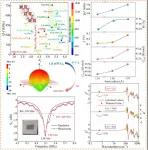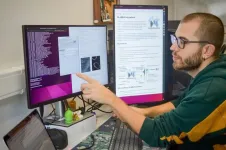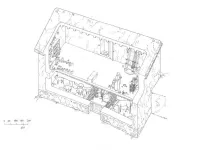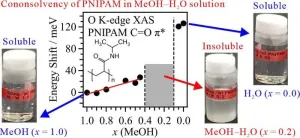Microwave dielectric ceramics are the cornerstone of wireless communication devices, widely utilized in mobile communications, satellite radar, GPS, Bluetooth, and WLAN applications. Components made from these ceramic materials, such as filters, resonators, and dielectric antennas, are extensively used in wireless communication networks. As wireless communication frequencies extend into higher bands, signal delay issues become increasingly prominent. Low dielectric constants (εr) can reduce electromagnetic coupling effects, effectively minimizing signal delays. Consequently, developing new ceramic materials with low dielectric constants has become a critical issue in this field. Additionally, exploring the intrinsic dielectric response mechanisms of dielectric ceramics to provide theoretical guidance for performance enhancement is a key focus for researchers in this domain.
The research group led by Professor Zidong Zhang from Shandong University has recently reported a pioneering new system of lightweight, low-dielectric constant, and low-loss microwave dielectric ceramics. This innovative system features a strongly covalent [PO4] tetrahedral framework, incorporating low-melting-point LiO2, and rare earth elements are introduced to achieve high-quality factor (Q·f) values. Based on the LiO2-Ln2O3-P2O5 ternary phase diagram, the LiLn(PO3)4 (Ln = La, Sm, Eu) system was successfully synthesized at sintering temperatures below 950°C, which exhibit a low dielectric constant (5.05–5.26), a high-quality factor (41,607–75,968 GHz), and low density (3.04–3.26 g/cm3), showcasing exceptional overall performance among low-dielectric materials.
The team published their review in the Journal of Advanced Ceramics on May 14, 2024.
“In this work, our research team reported a low-dielectric system based on phosphates. Building on systematic studies of orthophosphates (-PO4) and pyrophosphates (-P2O7), we identified a metaphosphate system within the stable regions of the phosphate phase diagram. By optimizing the preparation conditions, we achieved excellent dielectric properties. Additionally, with future device applications in mind, the research team designed a prototype microstrip patch antenna. Practical measurements closely match the simulation results, demonstrating the excellent performance of the antenna.” said Professor Zidong Zhang from the School of Materials Science and Engineering at Shandong University. Professor Zhang also serves as the Deputy Secretary-General of the Metamaterials Branch of the Chinese Materials Research Society.
“Furthermore, in this study, we conducted first-principles calculations based on the evolution of the crystal structure and performed P-V-L theoretical calculations using experimental XRD data. These calculations corroborated chemical bond properties, quantifying the impact of chemical bond parameters on microwave dielectric performance, and exploring the intrinsic response mechanisms of dielectric properties. Additionally, by examining the intrinsic contributions to microwave dielectric response through lattice vibration spectroscopy, we extrapolated the low-loss limit at microwave frequencies. This analysis indicates the potential of this structure to achieve even lower loss.” said Professor Zidong Zhang.
The research team aspires for this study to offer new material options for RF devices. Moreover, the exploration of low-loss limits and the investigation into the relationship between structure and performance can provide theoretical guidance for material modification. This will facilitate the development of millimeter-wave communication and improve signal delay.
The first author is Huanrong Tian from the School of Materials Science and Engineering of Shandong University, Other contribution includes Professor Yao Liu from the School of Materials Science and Engineering at Shandong University, and Xiaohan Zhang, Professor Haitao Wu from the School of Environmental and Material Engineering at Yantai University.
This work was supported by the National Natural Science Foundation of China (Grant No. 52272117, No. 52171141), the National Key Research and Development Program of China (2022YFB3505104, 2022YFB3706604).
About Journal of Advanced Ceramics
Journal of Advanced Ceramics (JAC) is an international journal that presents the state-of-the-art results of theoretical and experimental studies on the processing, structure, and properties of advanced ceramics and ceramic-based composites. JAC is Fully Open Access, monthly published by Tsinghua University Press on behalf of the State Key Laboratory of New Ceramics and Fine Processing (Tsinghua University) and the Advanced Ceramics Division of the Chinese Ceramic Society, and exclusively available via SciOpen. JAC has been indexed in SCIE (IF = 16.9, top 1/28, Q1), Scopus, and Ei Compendex.
About SciOpen
SciOpen is a professional open access resource for discovery of scientific and technical content published by the Tsinghua University Press and its publishing partners, providing the scholarly publishing community with innovative technology and market-leading capabilities. SciOpen provides end-to-end services across manuscript submission, peer review, content hosting, analytics, and identity management and expert advice to ensure each journal’s development by offering a range of options across all functions as Journal Layout, Production Services, Editorial Services, Marketing and Promotions, Online Functionality, etc. By digitalizing the publishing process, SciOpen widens the reach, deepens the impact, and accelerates the exchange of ideas.
END






